2.06.2024
China's Chang'e-6 lands on moon's far side to collect samples
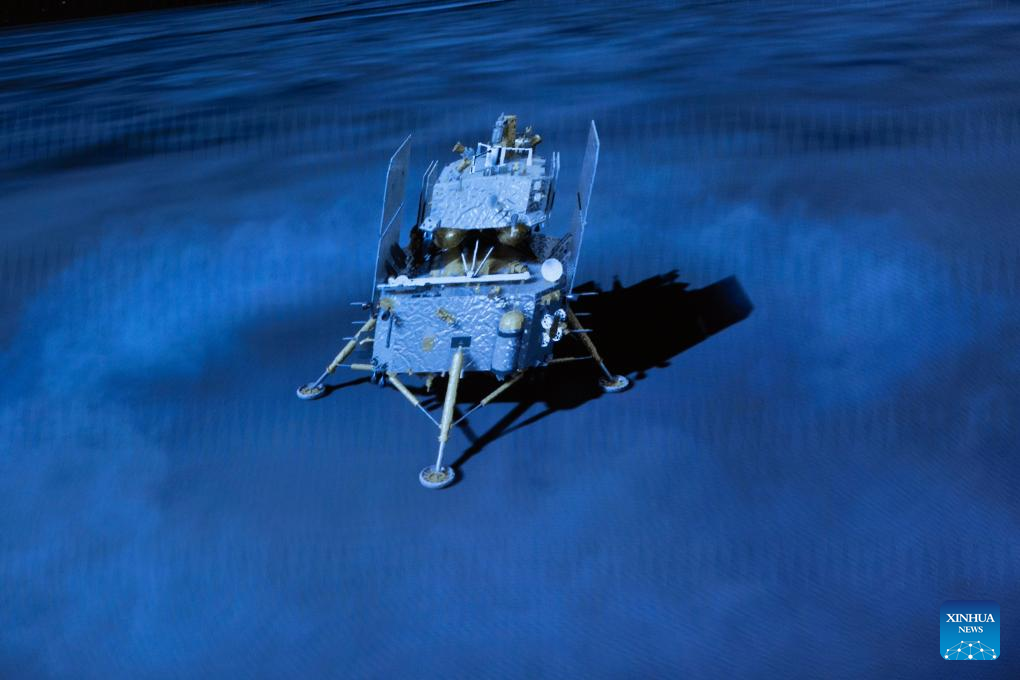
This image taken from video animation at Beijing Aerospace Control Center (BACC) on June 2, 2024 shows the lander-ascender combination of Chang'e-6 probe landing on the far side of the moon. China's Chang'e-6 touched down on the far side of the moon on Sunday morning, and will collect samples from this rarely explored terrain for the first time in human history, the China National Space Administration (CNSA) announced. Supported by the Queqiao-2 relay satellite, the lander-ascender combination of the Chang'e-6 probe successfully landed at the designated landing area at 6:23 a.m. (Beijing Time) in the South Pole-Aitken (SPA) Basin. (Xinhua/Jin Liwang)
China's Chang'e-6 touched down on the far side of the moon on Sunday morning, and will collect samples from this rarely explored terrain for the first time in human history, the China National Space Administration (CNSA) announced.
Supported by the Queqiao-2 relay satellite, the lander-ascender combination of the Chang'e-6 probe successfully landed at the designated landing area at 6:23 a.m. (Beijing Time) in the South Pole-Aitken (SPA) Basin.
Chang'e-6 consists of an orbiter, a returner, a lander and an ascender. Since its launch on May 3 this year, it has gone through various stages such as Earth-moon transfer, near-moon braking, lunar orbiting and landing descent. The lander-ascender combination separated from the orbiter-returner combination on May 30, said the CNSA.
The lander-ascender combination began the powered descent at 6:09 a.m.. The main engine with variable thrust was ignited, and the combination quickly adjusted its attitude and gradually approached the lunar surface.
During the descent, an autonomous visual obstacle avoidance system was used to automatically detect obstacles, with a visible light camera selecting a comparatively safe landing area based on the brightness and darkness of the lunar surface.
The combination then hovered about 100 meters above the safe landing area and used a laser 3D scanner to detect obstacles on the lunar surface to select the final landing site before a slow vertical descent. As the combination approached the lunar surface, it shut down the engine and touched down via free fall, protected by a cushioning system.
The Chang'e-6 mission is tasked with collecting and returning samples from the moon's far side, the first endeavor of its kind in the history of human lunar exploration.
It has achieved a breakthrough in the design and control technology of the lunar retrograde orbit and aims to realize key technologies of intelligent and rapid sampling, as well as takeoff and ascent from the far side of the moon.
The landing site is at an impact crater known as the Apollo Basin, located within the SPA Basin. The choice was made for the Apollo Basin's potential value of scientific exploration, as well as the conditions of the landing area, including communication and telemetry conditions and the flatness of the terrain, said Huang Hao, a space expert from the China Aerospace Science and Technology Corporation (CASC).
Huang added that the terrain on the far side of the moon is more rugged than the near side, with fewer continuous flat areas. However, the Apollo Basin is relatively flatter than other areas on the far side, which is conducive to landing.
The lander is equipped with multiple sensors, including microwave, laser and optical imaging sensors which can measure distance and speed, and identify obstacles on the lunar surface, Huang said.
To prevent interference to optical sensors by lunar dust during landing, the lander is also equipped with gamma-ray sensors to accurately measure the height through particle rays, ensuring that the engine can be shut down on time and the lander can touch down smoothly on the lunar surface, he added.
At the same time, the landing legs play their role as buffers, absorbing the impact energy of landing and ensuring the safety of the equipment on the lander.
After the landing, the probe is scheduled to complete sampling within two days. It has adopted two methods of moon sampling, which include using a drill to collect subsurface samples and grabbing samples on the surface with a robotic arm.
According to Jin Shengyi, another space expert from the CASC, the Chang'e-6 probe development team has built a simulation lab in advance to ensure a smooth sampling process.
The team members will set up a full-scale replica of the sampling area based on Chang'e-6 exploration results on the environment, rock distribution, and lunar soil conditions around the landing site. Using this simulation, they will develop and verify sampling strategies and equipment control procedures to ensure the accuracy of instructions.
Due to the moon's obstruction, the Earth-moon communication window period on the far side of the moon, even with the help of the Queqiao-2 relay satellite service, is still shorter than that on the near side. Therefore, the sampling time of Chang'e-6 will be reduced to about 14 hours, compared with the 22 hours used by its predecessor Chang'e-5.
To save time and improve efficiency, the development team has made the sampling process more intelligent, allowing Chang'e-6 to execute instructions and make judgments autonomously to reduce the Earth-moon interactions, Jin said.
For example, after the ground control sends an instruction, the probe will execute the corresponding program in multiple actions and then use the real-time data collected by the sensors to evaluate if the instruction is well executed, thus autonomously working in a closed loop without the ground control sending command on each action.
About 1,000 instructions were sent during the entire sampling process of Chang'e-5. For Chang'e-6, the number is expected to be reduced to about 400. ■
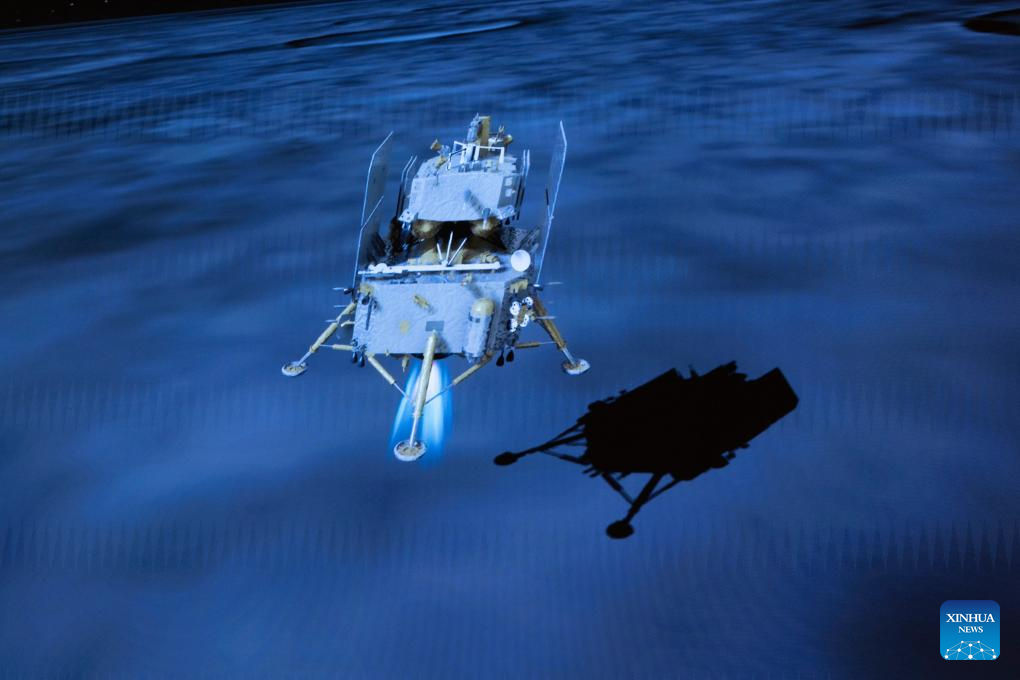
This image taken from video animation at Beijing Aerospace Control Center (BACC) on June 2, 2024 shows the lander-ascender combination of Chang'e-6 probe landing on the far side of the moon. China's Chang'e-6 touched down on the far side of the moon on Sunday morning, and will collect samples from this rarely explored terrain for the first time in human history, the China National Space Administration (CNSA) announced.
Supported by the Queqiao-2 relay satellite, the lander-ascender combination of the Chang'e-6 probe successfully landed at the designated landing area at 6:23 a.m. (Beijing Time) in the South Pole-Aitken (SPA) Basin. (Xinhua/Jin Liwang)
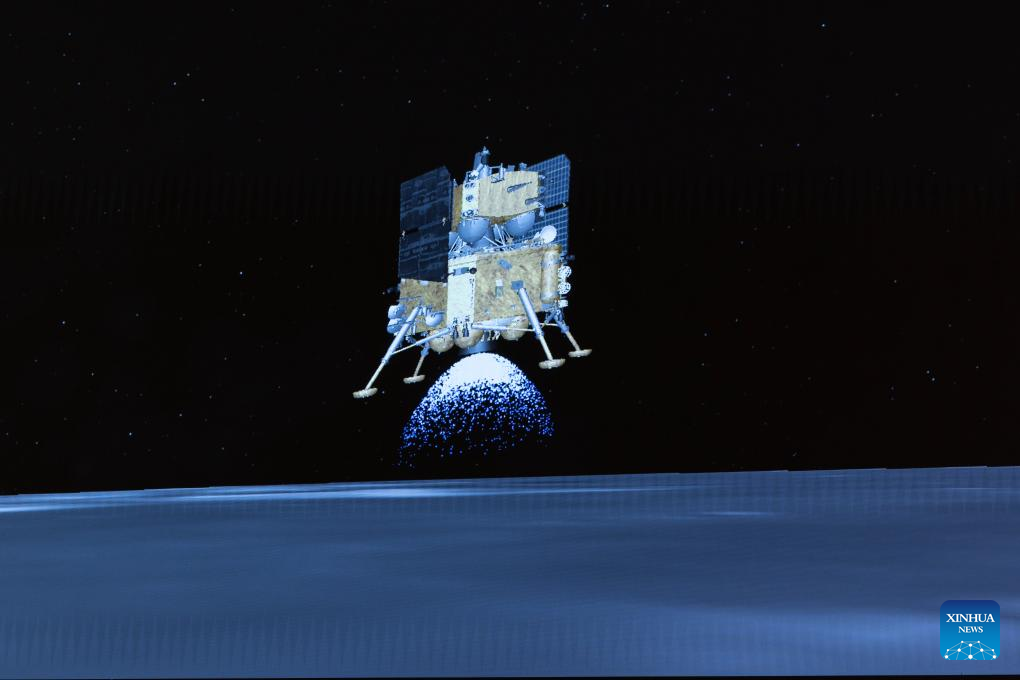
This image taken from video animation at Beijing Aerospace Control Center (BACC) on June 2, 2024 shows the lander-ascender combination of Chang'e-6 probe before landing on the far side of the moon. China's Chang'e-6 touched down on the far side of the moon on Sunday morning, and will collect samples from this rarely explored terrain for the first time in human history, the China National Space Administration (CNSA) announced.
Supported by the Queqiao-2 relay satellite, the lander-ascender combination of the Chang'e-6 probe successfully landed at the designated landing area at 6:23 a.m. (Beijing Time) in the South Pole-Aitken (SPA) Basin. (Xinhua/Jin Liwang)
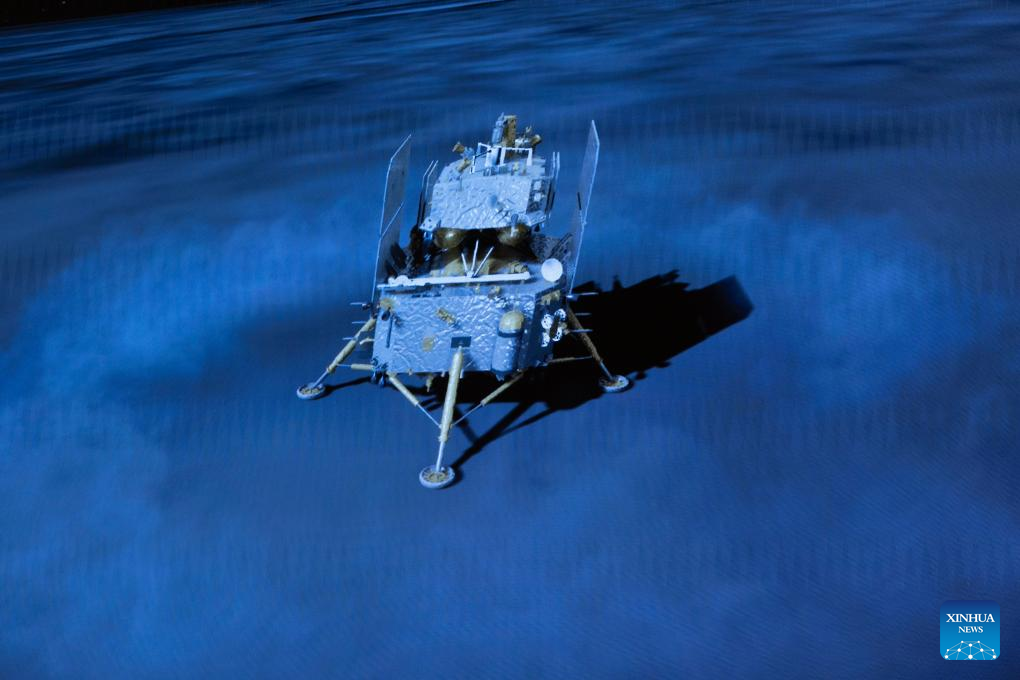
This image taken from video animation at Beijing Aerospace Control Center (BACC) on June 2, 2024 shows the lander-ascender combination of Chang'e-6 probe landing on the far side of the moon. China's Chang'e-6 touched down on the far side of the moon on Sunday morning, and will collect samples from this rarely explored terrain for the first time in human history, the China National Space Administration (CNSA) announced.
Supported by the Queqiao-2 relay satellite, the lander-ascender combination of the Chang'e-6 probe successfully landed at the designated landing area at 6:23 a.m. (Beijing Time) in the South Pole-Aitken (SPA) Basin. (Xinhua/Jin Liwang)
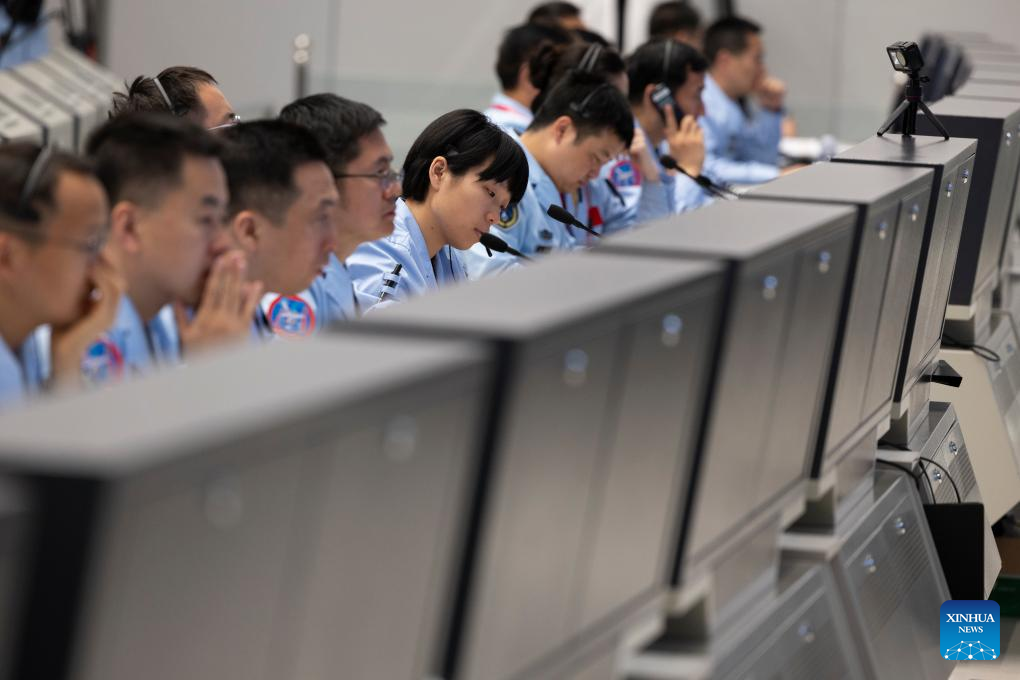
Technical personnel work at the Beijing Aerospace Control Center (BACC) in Beijing, capital of China, June 2, 2024. China's Chang'e-6 touched down on the far side of the moon on Sunday morning, and will collect samples from this rarely explored terrain for the first time in human history, the China National Space Administration (CNSA) announced.
Supported by the Queqiao-2 relay satellite, the lander-ascender combination of the Chang'e-6 probe successfully landed at the designated landing area at 6:23 a.m. (Beijing Time) in the South Pole-Aitken (SPA) Basin. (Xinhua/Jin Liwang)
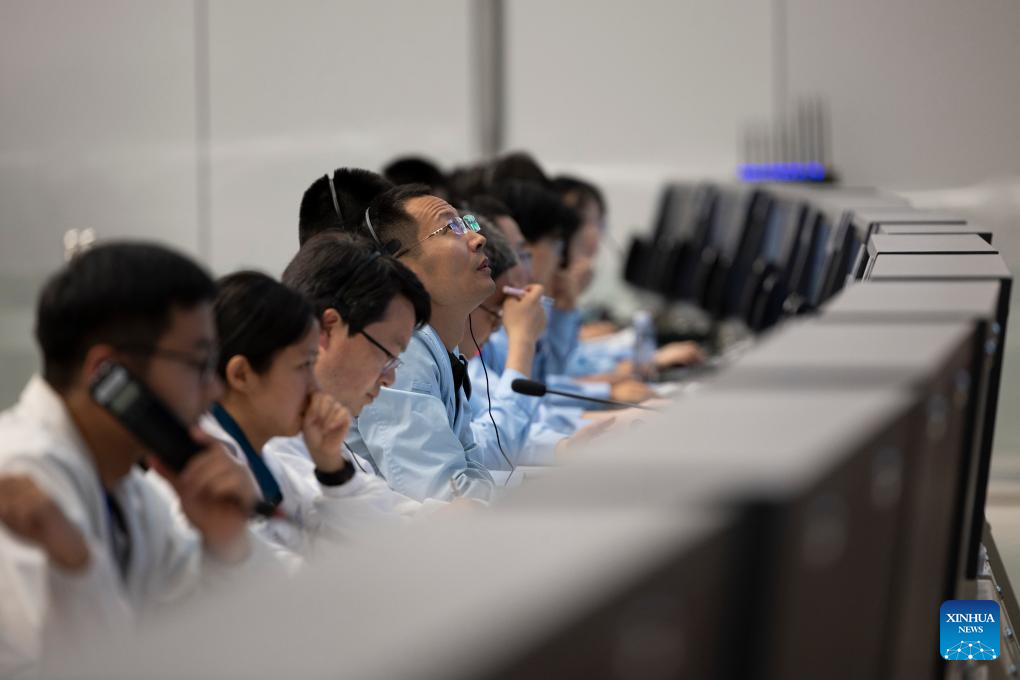
Technical personnel work at the Beijing Aerospace Control Center (BACC) in Beijing, capital of China, June 2, 2024. China's Chang'e-6 touched down on the far side of the moon on Sunday morning, and will collect samples from this rarely explored terrain for the first time in human history, the China National Space Administration (CNSA) announced.
Supported by the Queqiao-2 relay satellite, the lander-ascender combination of the Chang'e-6 probe successfully landed at the designated landing area at 6:23 a.m. (Beijing Time) in the South Pole-Aitken (SPA) Basin. (Xinhua/Jin Liwang)
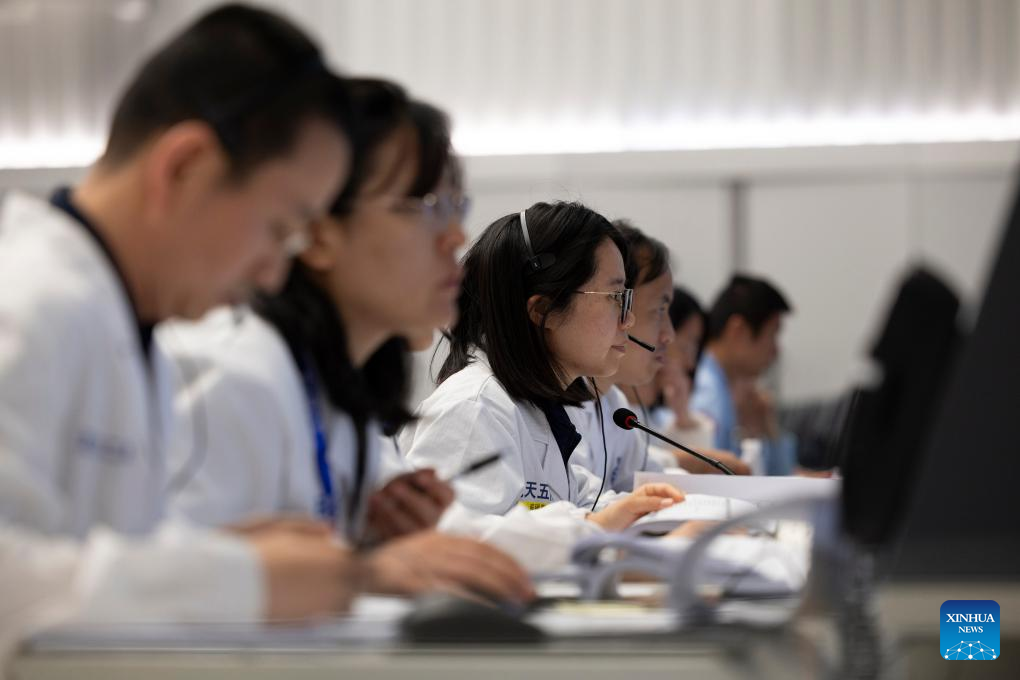
Technical personnel work at the Beijing Aerospace Control Center (BACC) in Beijing, capital of China, June 2, 2024. China's Chang'e-6 touched down on the far side of the moon on Sunday morning, and will collect samples from this rarely explored terrain for the first time in human history, the China National Space Administration (CNSA) announced.
Supported by the Queqiao-2 relay satellite, the lander-ascender combination of the Chang'e-6 probe successfully landed at the designated landing area at 6:23 a.m. (Beijing Time) in the South Pole-Aitken (SPA) Basin. (Xinhua/Jin Liwang)
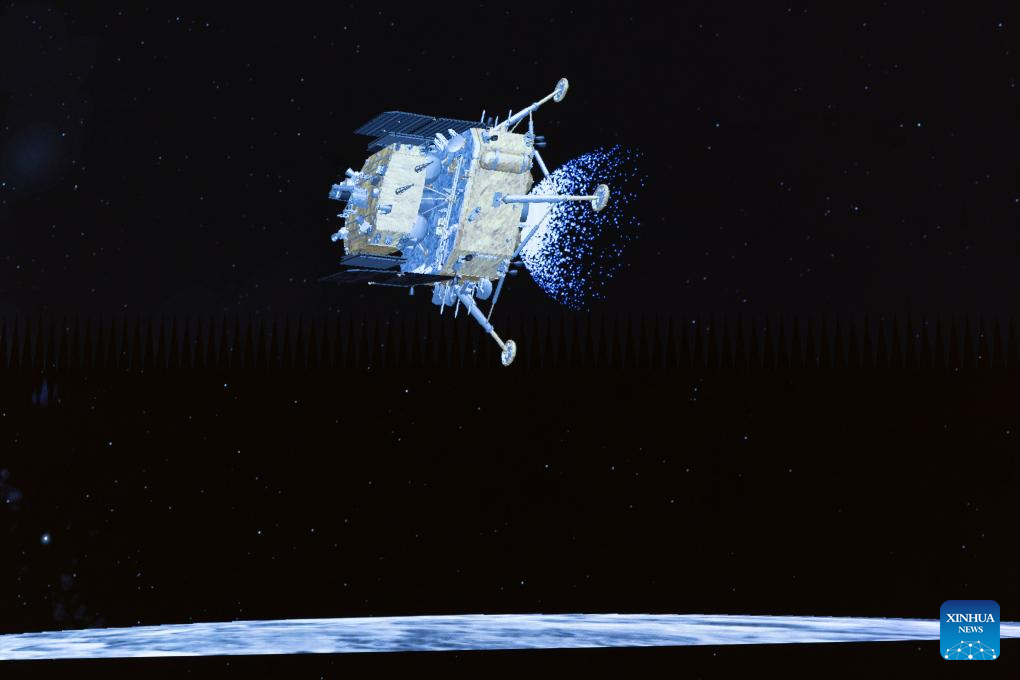
This image taken from video animation at Beijing Aerospace Control Center (BACC) on June 2, 2024 shows the lander-ascender combination of Chang'e-6 probe before landing on the far side of the moon. China's Chang'e-6 touched down on the far side of the moon on Sunday morning, and will collect samples from this rarely explored terrain for the first time in human history, the China National Space Administration (CNSA) announced.
Supported by the Queqiao-2 relay satellite, the lander-ascender combination of the Chang'e-6 probe successfully landed at the designated landing area at 6:23 a.m. (Beijing Time) in the South Pole-Aitken (SPA) Basin. (Xinhua/Jin Liwang)
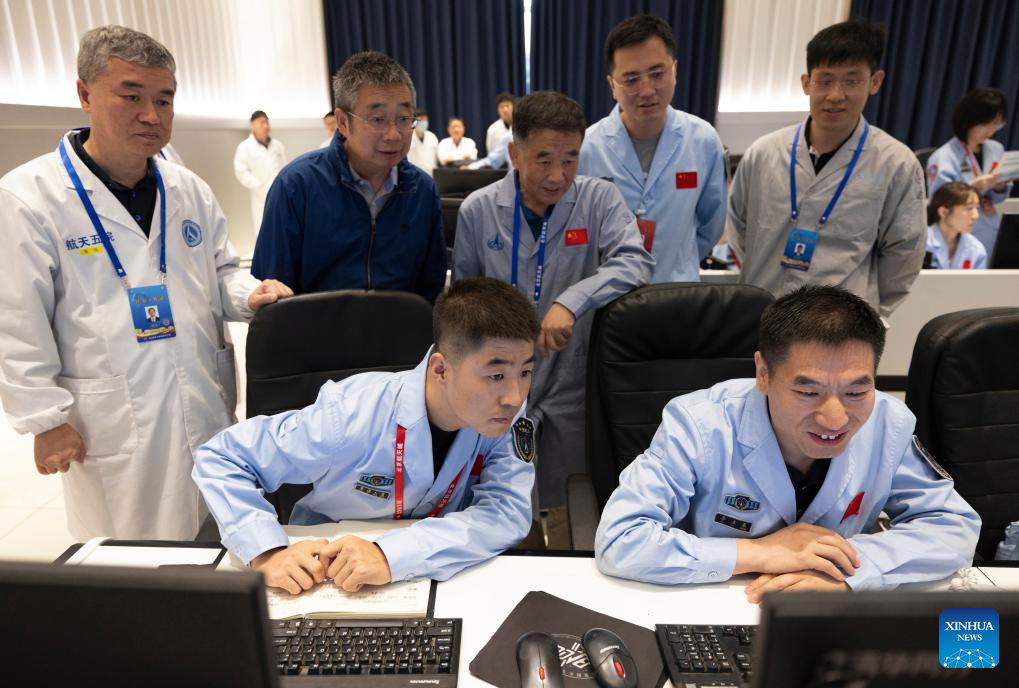
Technical personnel view data sent back by the lander-ascender combination of Chang'e-6 probe at the Beijing Aerospace Control Center (BACC) in Beijing, capital of China, June 2, 2024. China's Chang'e-6 touched down on the far side of the moon on Sunday morning, and will collect samples from this rarely explored terrain for the first time in human history, the China National Space Administration (CNSA) announced.
Supported by the Queqiao-2 relay satellite, the lander-ascender combination of the Chang'e-6 probe successfully landed at the designated landing area at 6:23 a.m. (Beijing Time) in the South Pole-Aitken (SPA) Basin. (Xinhua/Jin Liwang)
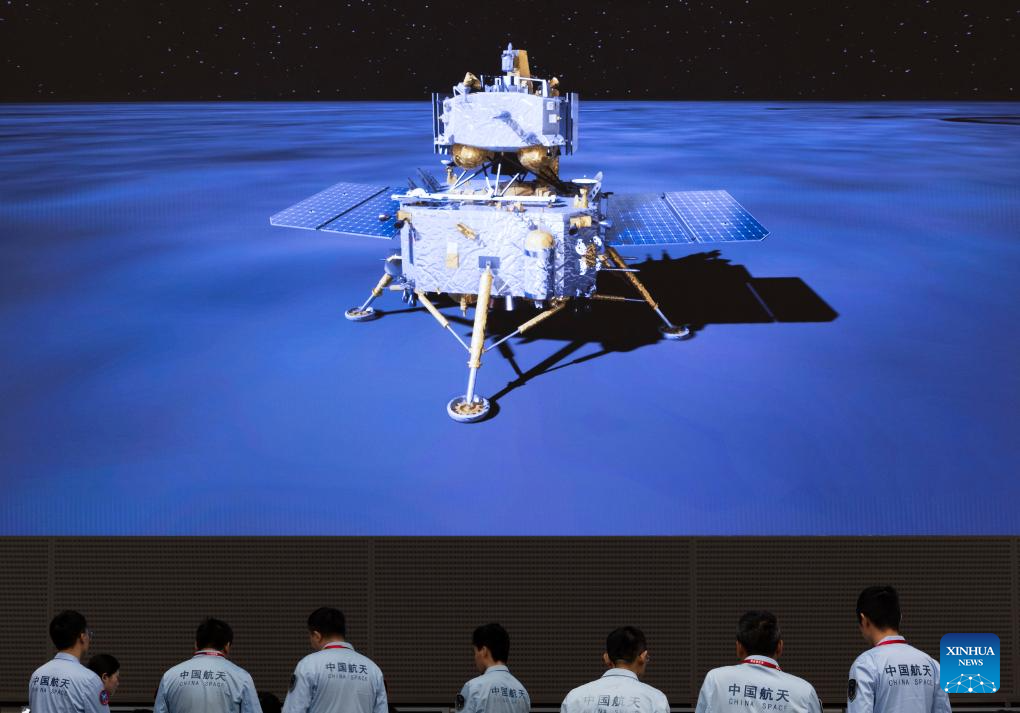
Technical personnel work at the Beijing Aerospace Control Center (BACC) in Beijing, capital of China, June 2, 2024. China's Chang'e-6 touched down on the far side of the moon on Sunday morning, and will collect samples from this rarely explored terrain for the first time in human history, the China National Space Administration (CNSA) announced.
Supported by the Queqiao-2 relay satellite, the lander-ascender combination of the Chang'e-6 probe successfully landed at the designated landing area at 6:23 a.m. (Beijing Time) in the South Pole-Aitken (SPA) Basin. (Xinhua/Jin Liwang)
Quelle: Xinhua
+++
A Chinese spacecraft lands on the moon's far side to collect rocks in growing space rivalry with US
A Chinese spacecraft has landed on the moon’s far side to collect rocks, in a growing space rivalry with U.S. The official Xinhua News Agency says the landing module touched down Sunday morning Beijing time
BEIJING -- A Chinese spacecraft landed on the far side of the moon Sunday to collect soil and rock samples that could provide insights into differences between the less-explored region and the better-known near side.
The landing module touched down at 6:23 a.m. Beijing time in a huge crater known as the South Pole-Aitken Basin, the China National Space Administration said.
The mission is the sixth in the Chang’e moon exploration program, which is named after a Chinese moon goddess. It is the second designed to bring back samples, following the Chang’e 5, which did so from the near side in 2020.
The moon program is part of a growing rivalry with the U.S. — still the leader in space exploration — and others, including Japan and India. China has put its own space station in orbit and regularly sends crews there.
The emerging global power aims to put a person on the moon before 2030, which would make it the second nation after the United States to do so. America is planning to land astronauts on the moon again — for the first time in more than 50 years — though NASA pushed the target date back to 2026 earlier this year.
U.S. efforts to use private-sector rockets to launch spacecraft have been repeatedly delayed. Last-minute computer trouble nixed the planned launchof Boeing's first astronaut flight Saturday.
Earlier Saturday, a Japanese billionaire called off his plan to orbit the moon because of uncertainty over the development of a mega rocket by SpaceX. NASA is planning to use the rocket to send its astronauts to the moon.
In China’s current mission, the lander is to use a mechanical arm and a drill to gather up to 2 kilograms (4.4 pounds) of surface and underground material over about two days.
An ascender atop the lander will then take the samples in a metal vacuum container back to another module that is orbiting the moon. The container will be transferred to a re-entry capsule that is due to return to Earth in the deserts of China’s Inner Mongolia region about June 25.
Missions to the moon’s far side are more difficult because it doesn’t face the Earth, requiring a relay satellite to maintain communications. The terrain is also more rugged, with fewer flat areas to land.
The South Pole-Aitken Basin, an impact crater created more than 4 billion years ago, is 13 kilometers (8 miles) deep and has a diameter of 2,500 kilometers (1,500 miles), according to a report by China's Xinhua News Agency.
It is the oldest and largest of such craters on the moon, so may provide the earliest information about it, Xinhua said, adding that the huge impact may have ejected materials from deep below the surface.
Quelle: abcNews
----
Update: 4.06.2024
.
China Focus: Foreign scientists thank China for sharing lunar exploration opportunity
After China's Chang'e-6 touched down on the far side of the moon Sunday morning to collect samples, foreign scientists participating in the mission expressed their excitement and thanks for taking their scientific instruments to the moon.
The Chang'e-6 mission carried four payloads developed through international cooperation, providing more opportunities for global scientists and merging human expertise in space exploration.
Scientific instruments from France, Italy and the European Space Agency (ESA)/Sweden are aboard the Chang'e-6 lander.
"Thank China so much for taking us to the moon," Sylvestre Maurice, a French astronomer from the University of Toulouse, said after he watched the landing process in a control room at the National Astronomical Observatories of the Chinese Academy of Sciences on Sunday.
"Today's landing is absolutely amazing. It's hard to land on a planet, and it's very hard especially on the moon. Don't think it's easy. Remember it's on the far side of the moon where we cannot see. And China had even to put another relay satellite to watch the landing. They landed right where they wanted to. So it's quite an achievement, something we've been looking for so many years," said Maurice.
Supported by the Queqiao-2 relay satellite, the lander-ascender combination of the Chang'e-6 probe successfully landed at the designated landing area at 6:23 a.m. (Beijing Time) in the South Pole-Aitken (SPA) Basin, according to the China National Space Administration.
"The far side of the moon is very unique. The South Pole-Aitken Basin is a huge basin. There was an impact long time ago to remove most of the crust, so we might have landed as close as possible to the mantle of the moon," Maurice said.
"As planetary scientists, the best thing we can dream of is to have samples in our lab. Nothing is better than having samples here, where we can study them and really go into the details of the story of the moon," said Maurice.
He mentioned that French scientists have got the lunar sample returned by the Chang'e-5 mission and would carry out research on it.
"We were very lucky to collaborate with China on different projects including the Chang'e lunar program and the Tianwen-1 Mars mission," he added.
Mathieu Grialou, a representative from the French space agency CNES, said Chang'e-6 will be the first mission to bring back samples from the far side of the moon. "We are very thrilled to be a small part of this very big mission."
"We are very happy to cooperate with China on this mission as China is now a big player in space," Grialou said. "It's great that we can contribute together to a better knowledge of the moon and our solar system."
A scientific instrument named Detection of Outgassing RadoN (DORN), developed by French scientists and onboard the lander of Chang'e-6, will detect radon isotopes and study the transmission and diffusion mechanisms of volatile compounds in the lunar environment.
Witnessing the landing of Chang'e-6, Pierre-Yves Meslin, principal investigator of DORN from France, said, "We have been thinking about this moment for years and even more intensely for the last few months and weeks and days. We were almost watching at the moon every night here in Beijing."
"We are very glad to be on the surface of the moon. Our instrument will start working. Now the pressure will be on us to succeed in our measurements," Meslin said.
He said the objective of the instrument is to study the origin and dynamics of the lunar exosphere. It will try to measure a radioactive gas called radon that is produced by lunar rocks in the lunar interior. "This gas might migrate from the warm regions of the moon to the cold regions of the moon, and we will try to understand its dynamics in the lunar environment. It will be the first time to measure it on the surface of the moon."
He mentioned that his team had a short time to develop the instrument, with only 3.5 years. "The schedule was very tight but we succeeded with the help of our Chinese partners."
"It's always good to share ideas with the different countries, which allows us to move forward to enrich our knowledge. As Europeans, we don't have the capacity to deploy our instruments on the surface of the moon yet. So we rely on international partners. China is now one of the most reliable partners that can safely land on the moon, as we have one more proof today," said Meslin.
Patrick Pinet, a scientist at the University of Toulouse, said Chang'e-6's landing seems smooth and easy, but it relies on a very heavy job and high skills. "And we're very impressed by what was achieved by China this time again."
"It's a very moving time for me," he said, noting that when he was 10 years old, he watched Neil Armstrong's landing on the moon on TV, and today it is his first experience of witnessing a landing on the far side of the moon in a control room in China. "It's 55 years later, and a lot of things have evolved through time."
"We really expect to have some success with this mission and with the next ones to come," he added.
The lander of the Chang'e-6 spacecraft also carried an instrument, called Negative Ions on the Lunar Surface (NILS), developed by the ESA/Sweden to the moon, which will be used to detect negative ions and study the interaction between plasma and the lunar surface.
Neil Melville-Kenney, NILS technical officer of the ESA, said the CNSA's initiative to invite international partners to participate in the Chang'e-6 mission is very much appreciated by the international community.
"It's a very impressive mission, a very ambitious mission. So we are very pleased to be a part of it. And the collaboration has gone very smoothly. Now we are waiting for the payload to be turned on so that we can get our first data," he said.
"It's very important to have international cooperation for space exploration. I think space exploration encourages us to consider our planet as one and our people as one. And it's important that we work together as we start to explore the solar system more and more. Together we can achieve greater things," he added.
Quelle: Xinhua
